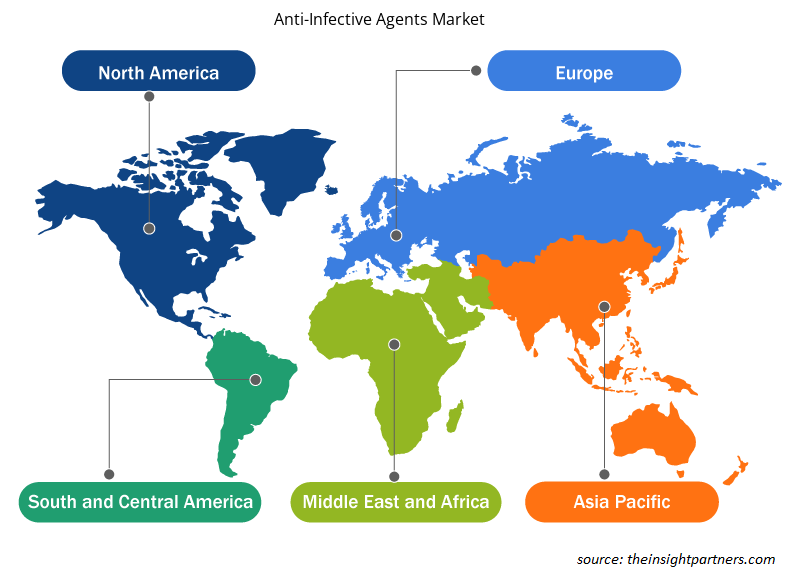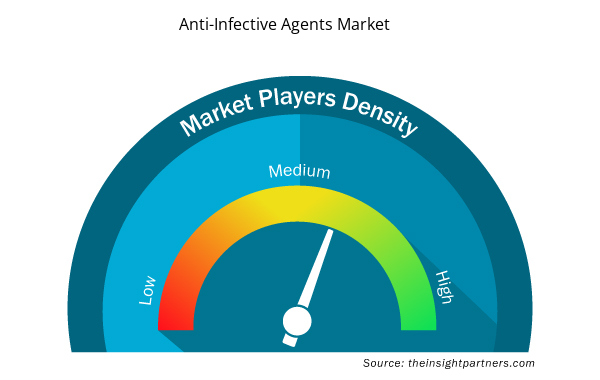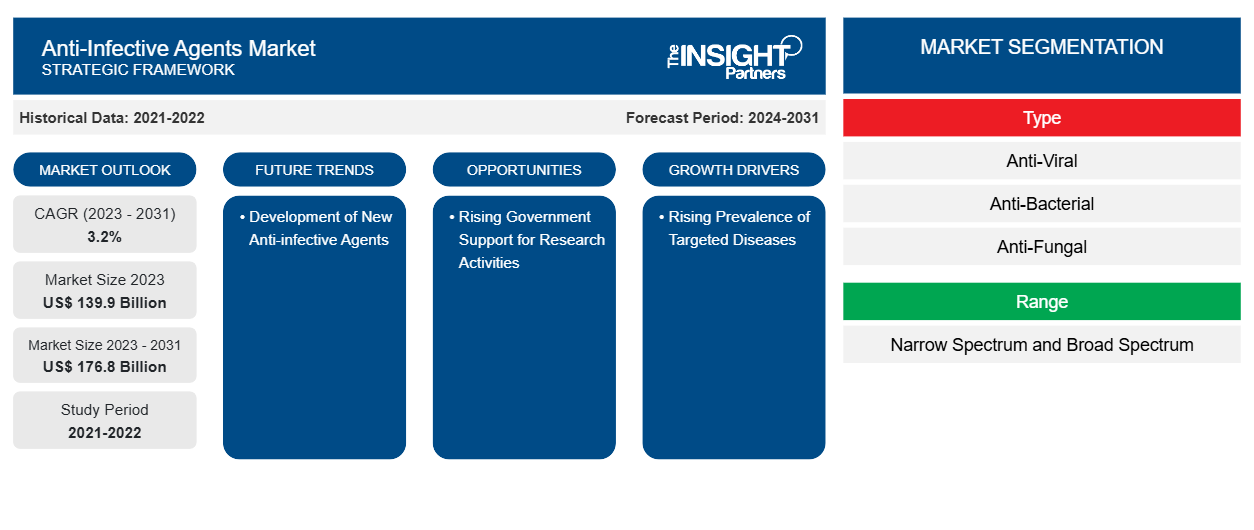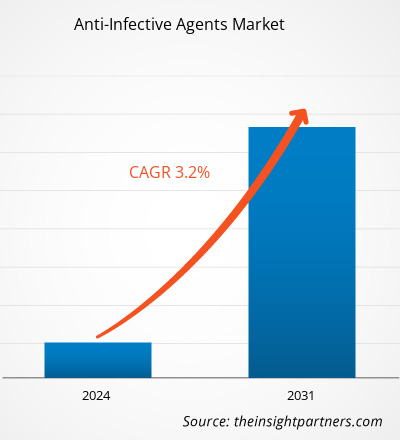Der Markt für Antiinfektiva soll von 139,9 Milliarden US-Dollar im Jahr 2023 auf 176,8 Milliarden US-Dollar im Jahr 2031 anwachsen. Für den Zeitraum 2023–2031 wird ein durchschnittliches jährliches Wachstum von 3,2 % erwartet. Innovationen bei Arzneimittelverabreichungssystemen werden voraussichtlich weiterhin wichtige Trends auf dem Markt bleiben.
Marktanalyse für Antiinfektiva
Die steigende Zahl an Infektionskrankheiten treibt das Wachstum des Marktes an. Laut der Weltgesundheitsorganisation (WHO) litten im Jahr 2022 weltweit 10,6 Millionen Menschen an Tuberkulose, was einem Anstieg gegenüber 10,3 Millionen im Jahr 2021 und 10,0 Millionen im Jahr 2020 entspricht. Ebenso schätzte die WHO im Jahr 2022, dass es weltweit 249 Millionen Malariafälle gab. Eine derart hohe Zahl an Infektionskrankheiten erhöht die Nachfrage nach Antiinfektiva.
Marktübersicht für Antiinfektiva
Die steigende Zahl an Infektionskrankheiten , die zunehmende Verbreitung von medikamentenresistenten Krankheitserregern, die zunehmende Überalterung der Bevölkerung, Innovationen bei der Arzneimittelforschung und -entwicklung, zunehmende Unterstützung durch staatliche Initiativen und Finanzierungen, die steigende Zahl an im Krankenhaus erworbenen Infektionen, ein stabiler Bestand an Antiinfektiva und ein steigendes öffentliches Bewusstsein für Infektionskrankheiten sind Faktoren, die das Wachstum des Marktes für Antiinfektiva vorantreiben.
Passen Sie diesen Bericht Ihren Anforderungen an
Sie erhalten kostenlos individuelle Anpassungen an jedem Bericht, einschließlich Teilen dieses Berichts oder einer Analyse auf Länderebene, eines Excel-Datenpakets sowie tolle Angebote und Rabatte für Start-ups und Universitäten.
- Holen Sie sich die wichtigsten Markttrends aus diesem Bericht.Dieses KOSTENLOSE Beispiel umfasst eine Datenanalyse von Markttrends bis hin zu Schätzungen und Prognosen.
Markttreiber und Chancen für Antiinfektiva
Zunehmendes Vorkommen medikamentenresistenter Erreger begünstigt den Markt
Die zunehmende Antibiotikaresistenz von Krankheitserregern erhöht die Nachfrage nach neuen Antiinfektiva. Nach Angaben der Centers for Disease Control and Prevention treten in den USA jedes Jahr über 2,8 Millionen antibiotikaresistente Infektionen auf. Ebenso schätzte die Jahreskonferenz der britischen Health Security Agency (UKHSA) nach den neuesten nationalen Überwachungsdaten, dass im Jahr 2022 58.224 Menschen in England an einer antibiotikaresistenten Infektion litten, was einem Anstieg von 4 % seit 2021 (55.792) entspricht.
Staatliche Unterstützung und Initiativen schaffen voraussichtlich Wachstumschancen
Die Unterstützung staatlicher Organisationen bei der Entwicklung neuer Antiinfektiva und der Verteilung von Antiinfektiva dürfte das Wachstum des Marktes begünstigen. So stellt die indische Regierung beispielsweise im Rahmen ihres National AIDS and STD Control Programme (NACP) HIV-Infizierten in Behandlungseinrichtungen im ganzen Land kostenlos hochwertige antiretrovirale Medikamente (ARV) zur Verfügung.anti-infective drugs and distribute anti-infective agents is likely to favor the growth of the market. For instance, the Government of India, through the National AIDS and STD Control Programme (NACP), will provide high-quality anti-retroviral (ARV) medicines free of cost to people suffering from HIV from treatment facilities across the country.
Um der HIV-Epidemie ein Ende zu setzen, investiert die US-Regierung Milliarden in HIV-Tests, Prävention, Behandlung und Forschungsinitiativen im ganzen Land und auf der ganzen Welt. Die US-Regierung gibt jährlich über 28 Milliarden US-Dollar aus, um die Umsetzung der Initiative „Ending the HIV Epidemic in the US“ (EHE) zu unterstützen.EHE).
Segmentierungsanalyse des Marktberichts zu Antiinfektiva Agents Market Report Segmentation Analysis
Wichtige Segmente, die zur Ableitung der Marktanalyse für antiinfektiöse Mittel beigetragen haben, sind Typ, Bereich, Tierart, Krankheitsart und Endverbraucher.anti-infective agents Market analysis are type, range, animal type, disease type, and end user.
- Der Markt für Antiinfektiva ist nach Typ in antibakterielle, antivirale, antimykotische und andere Mittel unterteilt. Das antivirale Segment hatte im Jahr 2022 den größten Marktanteil. Es wird erwartet, dass das antivirale Segment im Prognosezeitraum die höchste durchschnittliche jährliche Wachstumsrate (CAGR) auf dem Markt verzeichnet.anti-infective agents market, by type, is segmented into anti-bacterial, anti-viral, anti-fungal, and others. The anti-viral segment held the largest share of the market in 2022. The anti-viral segment is anticipated to register the highest CAGR in the market during the forecast period.
- Basierend auf der Reichweite ist der globale Markt für Antiinfektiva in Breitspektrum- und Schmalspektrum-Mittel unterteilt. Im Jahr 2023 hielt das Schmalspektrum-Segment den größten Marktanteil. Es wird jedoch erwartet, dass das Breitspektrum-Segment im Prognosezeitraum ein CAGR-Wachstum mit der höchsten Nachfrage verzeichnen wird.anti-infectives agents market is segmented into broad-spectrum, and narrow spectrum. In 2023, the narrow spectrum segment held the largest share of the market. However, the broad-spectrum segment is expected to witness growth in its demand at a fastest CAGR during the forecast period.
- Nach Verabreichungsweg ist der Markt in topische, orale, intravenöse und andere Verabreichungsarten unterteilt. Im Jahr 2023 hielt das intravenöse Segment den größten Marktanteil. Es wird jedoch erwartet, dass das topische Segment im Prognosezeitraum eine am schnellsten steigende Nachfrage im Bereich der durchschnittlichen jährlichen Wachstumsrate verzeichnen wird.CAGR during the forecast period.
- In Bezug auf die Indikation ist der globale Markt für Antiinfektiva in HIV, Tuberkulose, Atemwegsinfektionen, Lungenentzündung und andere unterteilt. Im Jahr 2022 wird das HIV-Segment voraussichtlich den größten Marktanteil haben. Darüber hinaus wird erwartet, dass die Nachfrage in diesem Segment im Prognosezeitraum mit der höchsten CAGR wächst.anti-infectives agents market is segmented into HIV, tuberculosis, respiratory infection, pneumonia, and others. In 2022, the HIV segment is likely to hold the largest share of the market. Moreover, the same segment is expected to witness growth in its demand at a fastest CAGR during the forecast period.
- Basierend auf den Vertriebskanälen ist der globale Markt für Antiinfektiva in Krankenhausapotheken, Spezialapotheken, E-Commerce und andere unterteilt. Im Jahr 2022 dürfte das Segment der Krankenhausapotheken den größten Marktanteil halten. Es wird jedoch erwartet, dass das Segment E-Commerce im Prognosezeitraum die höchste durchschnittliche jährliche Wachstumsrate (CAGR) auf dem Markt verzeichnet.anti-infectives agents market is segmented into hospital pharmacies, specialty pharmacies, e-commerce, and others. In 2022, the hospital pharmacies segment is likely to hold the largest share of the market. However, the e-commerce segment is anticipated to register the highest CAGR in the market during the forecast period.
Marktanteilsanalyse für Antiinfektiva nach geografischer Lage Agents Market Share Analysis by Geography
Der geografische Umfang des Marktberichts über Antiinfektiva ist hauptsächlich in fünf Regionen unterteilt: Nordamerika, Asien-Pazifik, Europa, Naher Osten und Afrika sowie Süd- und Mittelamerika.Anti-Infective Agents Market report is mainly divided into five regions: North America, Asia Pacific, Europe, Middle East & Africa, and South & Central America.
Der nordamerikanische Markt für Antiinfektiva ist in die USA, Kanada und Mexiko unterteilt. Die steigende Zahl von Produktzulassungen bei wachsenden Forschungs- und Entwicklungsaktivitäten sowie die steigende Nachfrage nach fortschrittlichen therapeutischen Lösungen zur Behandlung chronischer Erkrankungen und Viruserkrankungen zählen zu den wichtigsten Faktoren, die das Marktwachstum in dieser Region vorantreiben.anti-infective agents market has been segmented into the US, Canada, and Mexico. The increasing number of product approvals with growing research & development activities, and rising demand for advanced therapeutic solutions to treat chronic conditions and viral diseases are among the prominent factors propelling the market growth in this region.
Europa ist der zweitgrößte Markt aufgrund von Faktoren wie der steigenden Zahl älterer Menschen, der zunehmenden Verbreitung chronischer Viruserkrankungen und der hohen Nachfrage nach der Entwicklung neuer antiviraler Medikamente in der Region. Mit 15,79 Milliarden US-Dollar, die von 2007 bis 2019 durch das 7. Rahmenprogramm und Horizont 2020 bereitgestellt wurden, zusätzlich zu den 1,1 Milliarden US-Dollar, die für die Coronavirus-Forschung zugesagt wurden, spielt die EU eine entscheidende Rolle bei der Finanzierung und Koordinierung der Forschung zu Infektionskrankheiten.USD 15.79 billion funded from 2007 to 2019 through the 7th Framework Program and Horizon 2020, in addition to the USD 1.1 billion pledged for coronavirus research, the EU plays a crucial role in funding and coordinating research on infectious diseases.
Regionale Einblicke in den Markt für Antiinfektiva
Die regionalen Trends und Faktoren, die den Markt für Antiinfektiva im Prognosezeitraum beeinflussen, wurden von den Analysten von Insight Partners ausführlich erläutert. In diesem Abschnitt werden auch Marktsegmente und Geografie für Antiinfektiva in Nordamerika, Europa, im asiatisch-pazifischen Raum, im Nahen Osten und Afrika sowie in Süd- und Mittelamerika erörtert.

- Holen Sie sich die regionalen Daten für den Markt für Antiinfektiva
Umfang des Marktberichts zu Antiinfektiva
| Berichtsattribut | Details |
|---|---|
| Marktgröße im Jahr 2023 | 139,9 Milliarden US-Dollar |
| Marktgröße bis 2031 | 176,8 Milliarden US-Dollar |
| Globale CAGR (2023 - 2031) | 3,2 % |
| Historische Daten | 2021-2022 |
| Prognosezeitraum | 2024–2031 |
| Abgedeckte Segmente | Nach Typ
|
| Abgedeckte Regionen und Länder | Nordamerika
|
| Marktführer und wichtige Unternehmensprofile |
|
Marktdichte von Antiinfektiva: Auswirkungen auf die Geschäftsdynamik verstehen
Der Markt für Antiinfektiva wächst rasant, angetrieben durch die steigende Nachfrage der Endverbraucher aufgrund von Faktoren wie sich entwickelnden Verbraucherpräferenzen, technologischen Fortschritten und einem größeren Bewusstsein für die Vorteile des Produkts. Mit steigender Nachfrage erweitern Unternehmen ihr Angebot, entwickeln Innovationen, um die Bedürfnisse der Verbraucher zu erfüllen, und nutzen neue Trends, was das Marktwachstum weiter ankurbelt.
Die Marktteilnehmerdichte bezieht sich auf die Verteilung der Firmen oder Unternehmen, die in einem bestimmten Markt oder einer bestimmten Branche tätig sind. Sie gibt an, wie viele Wettbewerber (Marktteilnehmer) in einem bestimmten Marktraum im Verhältnis zu seiner Größe oder seinem gesamten Marktwert präsent sind.
Die wichtigsten auf dem Markt für Antiinfektiva tätigen Unternehmen sind:
- Abbott
- Allergan Plc.
- Astellas Pharma Inc.
- Merck & Co., Inc.
- Bayer AG
- Bristol-Myers Squibb Company
Haftungsausschluss : Die oben aufgeführten Unternehmen sind nicht in einer bestimmten Reihenfolge aufgeführt.

- Überblick über die wichtigsten Akteure auf dem Markt für Antiinfektiva
Nachrichten und aktuelle Entwicklungen zum Markt für Antiinfektiva
Der Markt für Antiinfektiva wird durch die Erhebung qualitativer und quantitativer Daten aus Primär- und Sekundärforschung bewertet, die wichtige Unternehmenspublikationen, Verbandsdaten und Datenbanken umfasst. Nachfolgend sind einige der Entwicklungen auf dem Markt für Antiinfektiva aufgeführt:
- Sandoz, eine Division von Novartis, gab die Verlängerung der Kooperationsvereinbarung mit Ares Genetics (Ares) bekannt, die darauf abzielt, hochmoderne digitale Lösungen im weltweiten Kampf gegen antimikrobielle Resistenzen (AMR) voranzutreiben. (Quelle: Sandoz, Pressemitteilung/Unternehmenswebsite/Newsletter, April 2022)
- Orchid Pharma ist eine Partnerschaft mit Cipla eingegangen, um seine bahnbrechende Antibiotika-Kombination in ganz Indien zu vertreiben. (Quelle: Cipla, Pressemitteilung/Unternehmenswebsite/Newsletter, Juli 2024)
Marktbericht zu Antiinfektiva: Umfang und Ergebnisse
Der Bericht „Marktgröße und Prognose für Antiinfektiva (2021–2031)“ bietet eine detaillierte Analyse des Marktes, die die folgenden Bereiche abdeckt:
- Marktgröße und Prognose für Antiinfektiva auf globaler, regionaler und Länderebene für alle wichtigen Marktsegmente, die im Rahmen des Berichts abgedeckt sind
- Markttrends und Marktdynamiken für Antiinfektiva wie Treiber, Einschränkungen und wichtige Chancen
- Detaillierte PEST/Porters Five Forces- und SWOT-Analyse
- Marktanalyse für Antiinfektiva, die wichtige Markttrends, globale und regionale Rahmenbedingungen, wichtige Akteure, Vorschriften und aktuelle Marktentwicklungen umfasst
- Branchenlandschaft und Wettbewerbsanalyse, die die Marktkonzentration, Heatmap-Analyse, prominente Akteure und aktuelle Entwicklungen für den Markt für Antiinfektiva umfasst
- Detaillierte Firmenprofile
- Historische Analyse (2 Jahre), Basisjahr, Prognose (7 Jahre) mit CAGR
- PEST- und SWOT-Analyse
- Marktgröße Wert/Volumen – Global, Regional, Land
- Branche und Wettbewerbsumfeld
- Excel-Datensatz


- Intraoperative Neuromonitoring Market
- Transdermal Drug Delivery System Market
- Mesotherapy Market
- Nuclear Decommissioning Services Market
- Artificial Intelligence in Defense Market
- Aerospace Forging Market
- Virtual Production Market
- Explosion-Proof Equipment Market
- Medical and Research Grade Collagen Market
- Wire Harness Market

Report Coverage
Revenue forecast, Company Analysis, Industry landscape, Growth factors, and Trends

Segment Covered
This text is related
to segments covered.

Regional Scope
North America, Europe, Asia Pacific, Middle East & Africa, South & Central America

Country Scope
This text is related
to country scope.
Häufig gestellte Fragen
The anti-infective agents market is estimated to grow with a CAGR of 3.2% from 2023 to 2031.
The estimated value of the anti-infective agents market by 2031 is US$ 176.8 billion billion
The anti-infectives agents market majorly consists of the players such as Abbott, Allergan Plc., Astellas Pharma Inc., Merck & Co., Inc., Bayer AG, Bristol-Myers Squibb Company, Boehringer Ingelheim International GmbH, F. HOFFMANN-LA ROCHE Ltd., Gilead Sciences, Inc., GlaxoSmithKline plc., Novartis AG among others.
Rising Investments in R&D Activities in Pharmaceutical Sector
The market drivers include rising prevalence of targeted diseases and rising government support for research activities and clinical trials are leading to increasing usage of anti-infectives agents market. However, emergence of anti-infective drugs resistance and their side effects is a key restraining factor for the market growth.
North America dominated the anti-infective agents market in 2023
Trends and growth analysis reports related to Life Sciences : READ MORE..
The Insight Partners performs research in 4 major stages: Data Collection & Secondary Research, Primary Research, Data Analysis and Data Triangulation & Final Review.
- Data Collection and Secondary Research:
As a market research and consulting firm operating from a decade, we have published and advised several client across the globe. First step for any study will start with an assessment of currently available data and insights from existing reports. Further, historical and current market information is collected from Investor Presentations, Annual Reports, SEC Filings, etc., and other information related to company’s performance and market positioning are gathered from Paid Databases (Factiva, Hoovers, and Reuters) and various other publications available in public domain.
Several associations trade associates, technical forums, institutes, societies and organization are accessed to gain technical as well as market related insights through their publications such as research papers, blogs and press releases related to the studies are referred to get cues about the market. Further, white papers, journals, magazines, and other news articles published in last 3 years are scrutinized and analyzed to understand the current market trends.
- Primary Research:
The primarily interview analysis comprise of data obtained from industry participants interview and answers to survey questions gathered by in-house primary team.
For primary research, interviews are conducted with industry experts/CEOs/Marketing Managers/VPs/Subject Matter Experts from both demand and supply side to get a 360-degree view of the market. The primary team conducts several interviews based on the complexity of the markets to understand the various market trends and dynamics which makes research more credible and precise.
A typical research interview fulfils the following functions:
- Provides first-hand information on the market size, market trends, growth trends, competitive landscape, and outlook
- Validates and strengthens in-house secondary research findings
- Develops the analysis team’s expertise and market understanding
Primary research involves email interactions and telephone interviews for each market, category, segment, and sub-segment across geographies. The participants who typically take part in such a process include, but are not limited to:
- Industry participants: VPs, business development managers, market intelligence managers and national sales managers
- Outside experts: Valuation experts, research analysts and key opinion leaders specializing in the electronics and semiconductor industry.
Below is the breakup of our primary respondents by company, designation, and region:

Once we receive the confirmation from primary research sources or primary respondents, we finalize the base year market estimation and forecast the data as per the macroeconomic and microeconomic factors assessed during data collection.
- Data Analysis:
Once data is validated through both secondary as well as primary respondents, we finalize the market estimations by hypothesis formulation and factor analysis at regional and country level.
- Macro-Economic Factor Analysis:
We analyse macroeconomic indicators such the gross domestic product (GDP), increase in the demand for goods and services across industries, technological advancement, regional economic growth, governmental policies, the influence of COVID-19, PEST analysis, and other aspects. This analysis aids in setting benchmarks for various nations/regions and approximating market splits. Additionally, the general trend of the aforementioned components aid in determining the market's development possibilities.
- Country Level Data:
Various factors that are especially aligned to the country are taken into account to determine the market size for a certain area and country, including the presence of vendors, such as headquarters and offices, the country's GDP, demand patterns, and industry growth. To comprehend the market dynamics for the nation, a number of growth variables, inhibitors, application areas, and current market trends are researched. The aforementioned elements aid in determining the country's overall market's growth potential.
- Company Profile:
The “Table of Contents” is formulated by listing and analyzing more than 25 - 30 companies operating in the market ecosystem across geographies. However, we profile only 10 companies as a standard practice in our syndicate reports. These 10 companies comprise leading, emerging, and regional players. Nonetheless, our analysis is not restricted to the 10 listed companies, we also analyze other companies present in the market to develop a holistic view and understand the prevailing trends. The “Company Profiles” section in the report covers key facts, business description, products & services, financial information, SWOT analysis, and key developments. The financial information presented is extracted from the annual reports and official documents of the publicly listed companies. Upon collecting the information for the sections of respective companies, we verify them via various primary sources and then compile the data in respective company profiles. The company level information helps us in deriving the base number as well as in forecasting the market size.
- Developing Base Number:
Aggregation of sales statistics (2020-2022) and macro-economic factor, and other secondary and primary research insights are utilized to arrive at base number and related market shares for 2022. The data gaps are identified in this step and relevant market data is analyzed, collected from paid primary interviews or databases. On finalizing the base year market size, forecasts are developed on the basis of macro-economic, industry and market growth factors and company level analysis.
- Data Triangulation and Final Review:
The market findings and base year market size calculations are validated from supply as well as demand side. Demand side validations are based on macro-economic factor analysis and benchmarks for respective regions and countries. In case of supply side validations, revenues of major companies are estimated (in case not available) based on industry benchmark, approximate number of employees, product portfolio, and primary interviews revenues are gathered. Further revenue from target product/service segment is assessed to avoid overshooting of market statistics. In case of heavy deviations between supply and demand side values, all thes steps are repeated to achieve synchronization.
We follow an iterative model, wherein we share our research findings with Subject Matter Experts (SME’s) and Key Opinion Leaders (KOLs) until consensus view of the market is not formulated – this model negates any drastic deviation in the opinions of experts. Only validated and universally acceptable research findings are quoted in our reports.
We have important check points that we use to validate our research findings – which we call – data triangulation, where we validate the information, we generate from secondary sources with primary interviews and then we re-validate with our internal data bases and Subject matter experts. This comprehensive model enables us to deliver high quality, reliable data in shortest possible time.


 Holen Sie sich ein kostenloses Muster für diesen Bericht
Holen Sie sich ein kostenloses Muster für diesen Bericht